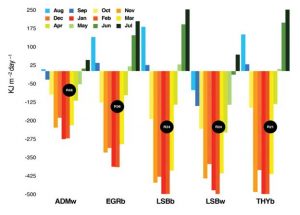Winter heating penalty

While a cool roof reduces cooling energy demand in the summer, it can increase heating energy demand in the winter when installed in some cold climates. This is known as the “winter heating penalty,” and though it is an issue to be factored into energy savings determinations, its effects are often greatly exaggerated for a number of reasons. In the winter, the sun is generally at a lower angle and days are shorter than in the summer months. In fact, in northern locations, winter solar irradiance is only 20 to 35 percent of what is experienced in the summer months, which means the sun has a reduced impact on roof surface temperature during the winter. Heating loads and expenditures are typically more pronounced in the evenings, whereas the benefit of a darker roof in the winter is mostly realized during daylight hours. Further, many commercial buildings require space cooling all year, due to human activity or equipment usage, thereby negating what little, if any, heating benefit would be achieved by a dark roof.
Snow cover on roofs also affects the winter heating penalty. Snow has two impacts on the roof which are relevant to understanding the true impact of roof surface reflectivity on energy consumption. First, snow helps insulate the roof. As a porous medium with high air content, snow conducts less heat than soil. This effect generally increases with snow density and thickness. Second, at a thickness of about 101.6 mm (4 in.), snow will transform any roof into a highly reflective surface (approximately 0.6 to 0.9 solar reflectance). Researchers evaluated the impact of reflective roofs on new and older-vintage commercial buildings in Anchorage, Alaska; Milwaukee, Wisconsin; Montreal, Quebec; and Toronto, Ontario, when snow cover is factored in. The study finds “cool roofs for the simulated buildings resulted in annual energy expenditure savings in all cold climates.” The study also identified peak energy savings in addition to the base energy-efficiency gains.

Another argument often heard against reflective roofing in cold climates is buildings in northern locations tend to have higher levels of roof insulation which reduce or negate the energy-saving impact of roof surface color. A field study and model analysis of black and white roof membranes over various levels of insulation by City University of New York, Princeton University, and Princeton Plasma Physics Lab showed the relationship between roof reflectivity and insulation is symbiotic, not a trade-off. The Princeton papers highlight the interconnected role of reflectivity and insulation in roofing systems, and find reflectivity is the variable that minimizes heat flux during the summer, while insulation levels are the driving variable during the winter. In other words, to have a high-performance roofing system which minimizes heat gain in the summer and heat loss in the winter, buildings need both insulation and a highly reflective roof surface.
The researchers deployed high-resolution heat-flux sensors over and through various roofs on buildings inside the Princeton University campus. The buildings were very similar in design and usage, with the exception of different roof membranes (black or white) and thicknesses of polymer-based insulation (resistance values [R-values] from R-21 to R-48).
This study, which gathered measurements for one year, is one of the first to directly observe heat fluxes entering and leaving buildings. It is the first study to pair a field test with an evaluation of the same buildings using a finely resolved model to validate and more deeply understand the interaction between insulation levels and surface reflectivity.
Figure 5 shows the net heat entering (positive values) or leaving (negative values) the building by month for each roof. The findings are better observed on the two buildings with R-24 insulation levels but different membrane colors (LSBb is black and LSBw is white). These two roofs were installed at the same time on buildings which are close to one another. During the cold months, both the white and black roofs allow roughly the same amount of heat to escape from the building. In the summer months, however, the white roof has substantially less heat gain than the black roof and even maintains a negative heat flux in August and September. The benefits of cool roofs are still evident in the building with R-48 insulation (ADMw). There is a net reduction in heat flux in the roof with the highly reflective surface.




